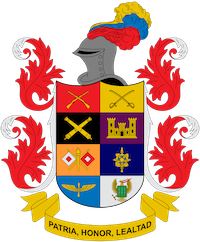Development of an HF antenna leveling system for irregular terrain in Colombia
Abstract
The antenna fields used in the high frequency band are essential for the execution of tactical direction-finding operations of Electronic Warfare in signals intelligence. These systems require in their structural bases high leveling accuracy and stability to optimize and guarantee communication links. The implementation of each support and preparation of anchorage area requires high budgets and costs for civil works, since areas where they are distributed and configured are topographically irregular and difficult to access. The present study was carried out in order to develop a prototype of mechanical support for high frequency antennas leveling. Mixed research (qualitative and quantitative) of descriptive approach was applied to design and development of prototype called Keops, an alternative that provides robustness and efficiency to stabilize in a practical and safe way each antenna on irregular surfaces, with the advantage of being an easily transportable structure and with mechanical arrangement designed for that purpose. In addition, costs of adaptation, implementation or relocation of high frequency antenna systems are reduced, since there is no need for anchorages or structures that require leveling or flattening of the ground with concrete or other types of materials.
However, a theoretical review of several key concepts related to direction finding and HF antenna fields was developed. This is to make known what the needs are for developing a prototype of these characteristics for the Colombian National Army.
Downloads
References
Andagana Junta, O. M. (2008). Estudio de Factibilidad de un nuevo sistema nacional de comprobación técnica del espectro radioeléctrico para la Superintendencia de Telecomunicaciones. Escuela Politécnica Nacional. Obtenido de https://bibdigital.epn.edu.ec/bitstream/15000/16789/1/CD-1430.pdf
Barbosa Reyes, W. M. (2016). Desafíos de la Inteligencia Militar del Ejército Nacional en un escenario de posconflicto. Repositorio Universidad Militar Nueva Granada. Recuperado de: http://hdl.handle.net/10654/14467.
Chiavaro, G. D. (2018). La influencia de la guerra electrónica en el diseño operacional. cefadigital.edu.ar. Repositorio Digital del Centro Educativo de las Fuerzas Armadas – CEFADIGITAL. http://cefadigital.edu.ar/handle/1847939/1192
Cruz González, J., & Piniella Corbacho, F. (2015). Los comienzos del oficial radiotelegrafista marítimo en España. Llull Revista de la Sociedad Española de Historia de las Ciencias y de las Técnicas, 38(82), 259-290. https://recyt.fecyt.es/index.php/LLUL/article/view/43701
Cruz González, J., & Piniella Corbacho, F. (2018). Introducción e implantación de la radiogoniometría en la Marina Civil española: génesis de la radionavegación en España. Llull Revista de la Sociedad Española de Historia de las Ciencias y de las Técnicas, 41(85), 163-190. https://recyt.fecyt.es/index.php/LLUL/article/view/68407
Esteves, L. A., Caicedo, G., & Murcia, F. (2012). Field tests for assessing electrical protection performance regarding electromechanical protection relays. Ingeniería e Investigación, 32(3), 71-75. http://www.scielo.org.co/scielo.php?script=sci_arttext&pid=S0120-56092012000300014
Galindo Mier, R. (2020). El radio cognitivo en la guerra electrónica. Telemática Revista digital de las tecnologías de la información y las telecomunicaciones, 19(3), 23–37. https://revistatelematica.cujae.edu.cu/index.php/tele/article/download/405/378/1231
Gross, F. (2015). Smart antennas with matlab: principlesand applications in wireless communication. Mc Graw – Hill https://www.accessengineeringlibrary.com/binary/mheaeworks/8be89cb14558458f/902b67141f15173a4525a008f1e508fed692daea4f90a165f47378cba07aaf87/book-summary.pdf
Guevara Albán, G. P., Verdesoto Arguello, A. E., & Castro Molina, N. E. (2020). Metodologías de investigación educativa (descriptivas, experimentales, participativas, y de investigación-acción). RECIMUNDO, 4(3), 163-173. https://doi.org/10.26820/recimundo/4.(3).julio.2020.163-173
Gunashekar, S., E. Michael Warrington, Hal J., Yvon Erhel, Sana Salous, Stuart M., Nasir M., Louis Bertel, Dominique Lemur, François Marie, & Martial Oger. (2009). Utilization of antenna arrays in HF systems. Annals of Geophysics, 52(3–4), 323-338. https://doi.org/10.4401/ag-4578
Hernández Estupiñán, P. A. (2021). Aportes al concepto de inteligencia estratégica. Revista Perspectivas en Inteligencia, 12(21), 81–94. https://doi.org/10.47961/2145194X.233
Hernández Hernández, M. (2014). Radiobalizas y radiogoniometría: Identificación y localización. RIULL Repositorio Universidad de La Laguna. http://riull.ull.es/xmlui/handle/915/333
Hernández Sampieri, R., Fernández Collado, C., & Baptista Lucio, P. (2014). Metodología de la Investigación (Ed.; Sexta). McGRAW-HILL / Interamericana Editores, S.A. de C.V.
Herrera, A. O. (2017). Diseño y planificación de las actividades de guerra electrónica en el ambiente operacional. cefadigital.edu.ar. Repositorio Digital del Centro Educativo de las Fuerzas Armadas – CEFADIGITAL. http://www.cefadigital.edu.ar/handle/1847939/1174
Liendo Ramos, M. E. (2021). Optimización de la doctrina de empleo de la compañía de inteligencia en los escenarios de guerra convencional y no convencional. Repositorio de la Escuela Superior de Guerra de Perú. http://repositorio.esge.edu.pe/handle/20.500.14141/193
López Perpiñá, R. (2021). Sistemas de Radiogoniometría. UPCommons. Portal de acceso abierto al conocimiento de la UPC. http://hdl.handle.net/2117/351449
Ma, R., & Behdad, N. (2019). Design of Platform-Based HF Direction-Finding Antennas Using the Characteristic Mode Theory. IEEE Transactions on Antennas and Propagation, 67(3), 1417–1427. https://doi.org/10.1109/TAP.2018.2884878
Morillo Alcívar, P. A. (2016). Estudio de factibilidad de la conexión de dos equipos de radiogoniometría para la determinación de la señal de telefonía móvil celular, tecnología GSM. BIBDIGITAL- Repositorio de la Escuela Politécnica Nacional. http://bibdigital.epn.edu.ec/handle/15000/16964
Proyecto BAIDI. (2022). Documento de recomendación de instalación. Proyecto de desarrollo tecnológico del BAIDI.
Ramos Rojas, G. (2016). Monitoreo “pasivo” de comunicaciones: Una maniobra lícita de inteligencia para la supervivencia del Estado. Revista de Derecho, Comunicaciones y Nuevas Tecnologías, 16, 1–27. https://derechoytics.uniandes.edu.co/index.php?option=com_content&view=article&id=246%3Amonitoreo-pasivo-de-comunicaciones-una-maniobra-licita-de-inteligencia-para-la-supervivencia-del-estado&catid=20%3A16&Itemid=96&lang=es
Rohde & Schwarz. (2019). R&S®DDF5GTS High-Speed Scanning Direction Finder Fast, accurate direction finding. https://scdn.rohde-schwarz.com/ur/pws/dl_downloads/dl_common_library/dl_brochures_and_datasheets/pdf_1/DDF5GTS_bro_en_3606-8137-12_v0700.pdf
Rohde & Schwarz. (2020). R&S®ADD011SR Super-resolution HF DF antenna. https://www.rohde-schwarz.com/es/productos/seguridad-para-el-sector-aeroespacial-y-de-defensa/opciones-de-receptores-y-radiogoniometros/rs-add011sr_63493-10869.html
Sánchez, T., Redondo, A. D., García, A. F., Gómez, C., Betancur, L., & Hincapié, R. C. (2015). Implementaciones en Hardware de técnicas de Radiogoniometría. Ingeniería y Región, 14(2), 23–33. https://doi.org/10.25054/22161325.690
Salazar Vargas, C. (1994) Dossier, Definición de política pública. https://proyectos.javerianacali.edu.co/cursos_virtuales/posgrado/maestria_asesoria_familiar/proyectos_I/m%C3%B3dulo%202/C_Salazar.pdf
Schacht, W. H. (2011). Small business innovation research (SBIR) program. Congressional Research Service.
Torres Garzón, E. A., Guevara Cardona, J. C., & Mendoza Prieto, Y. O. (2022). Estudio sobre el desarrollo de un prototipo para monitoreo del espectro radioelectrónico utilizando SDR. Revista Perspectivas en Inteligencia, 14(23), 303–323. https://doi.org/10.47961/2145194X.344
Unión Internacional de Telecomunicaciones. (2002). Recomendación SM.1598 Métodos de radiogoniometría y localización de señales de acceso múltiple por división en tiempo y acceso múltiple por división de código. SM.1598-0 (10/2002). Obtenido de https://www.itu.int/rec/R-REC-SM.1598-0-200210-W/es
Zarza, L. A. (2016). Estrategia militar y su transfiguración en la era de la información. Visión conjunta, 15, 4–14. cefadigital.edu.ar. Repositorio Digital del Centro Educativo de las Fuerzas Armadas – CEFADIGITAL. http://www.cefadigital.edu.ar/handle/1847939/640
Copyright (c) 2023 Diana Patricia Gómez Vargas, Diego Arley Velosa Castañeda, Juan Wilfredo Pinto Uribe, Julian Camilo Guevara Cardona (Autor/a)

This work is licensed under a Creative Commons Attribution-NonCommercial-NoDerivatives 4.0 International License.













